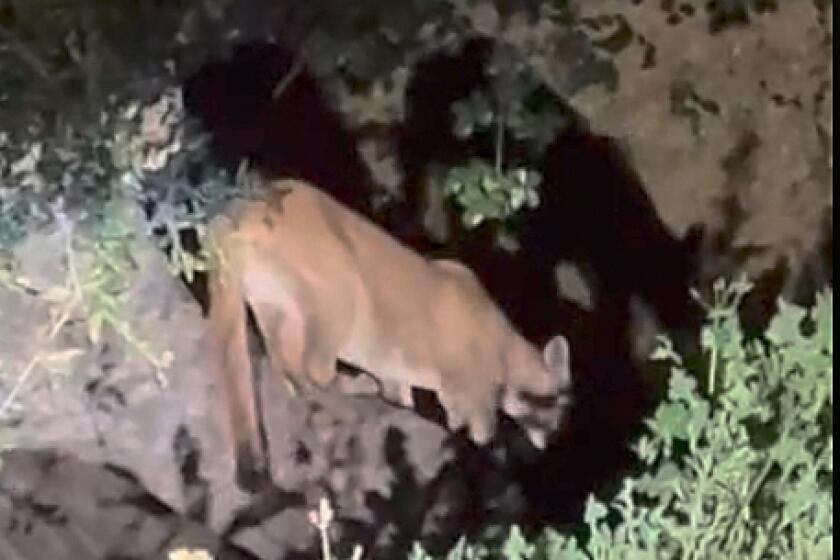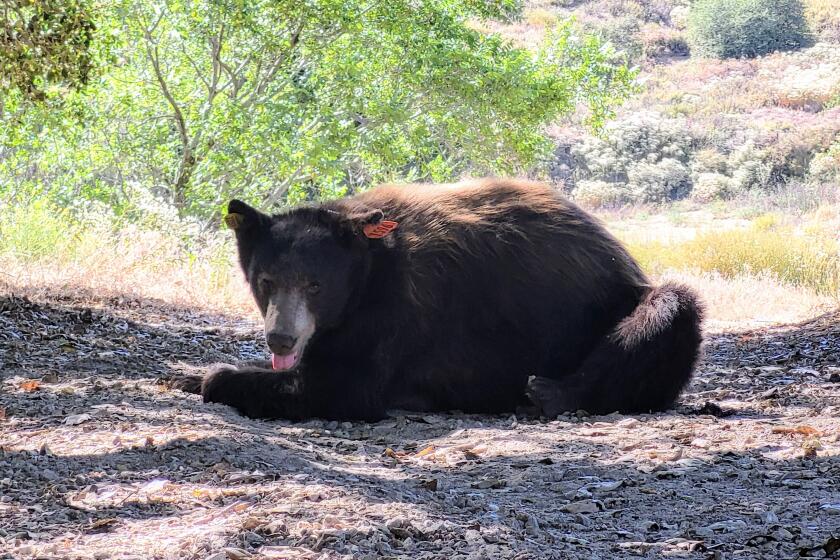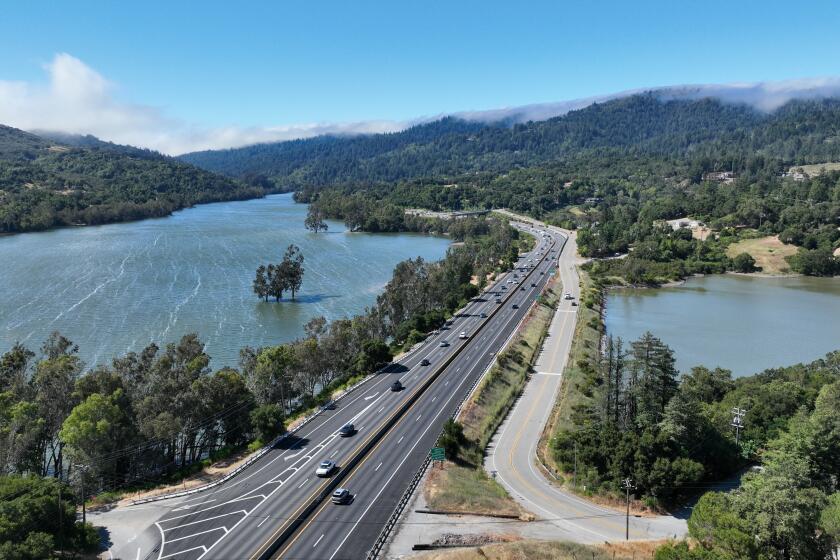Editorial: Good fences make for safer mountain lions

- Share via
On July 4, a mountain lion’s body was found on the northbound side of the 405 Freeway near the Getty Center. Less than a month earlier, another mountain lion had been discovered dead on the 101 Freeway in Agoura Hills.
One was evidently killed by a vehicle strike. The lion on the 405 was probably struck as well but has yet to be necropsied. They are among the rising road mortalities for these majestic animals. In the 22 years that the National Park Service has been collaring and tracking local mountain lions, 44 have been killed on nearby roads. Only 13 of those lions were collared and in the study. The others — including the two lions killed in the last month — were not in the study that tracks lions in and around the Santa Monica Mountains.
The lion in Agoura Hills was killed close to the state-of-the-art wildlife crossing under construction over the treacherous 101 that is expected to open in 2026. The lion found on the 405 was not far from the Sepulveda Boulevard underpass, which animals sometimes use and is safer than crossing the freeway.
P-22 was weakened by rat poison and a presumed car strike. We can do better by his successor.
Wildlife crossings are the only way that all kinds of creatures can safely cross roads and highways in some areas. But there are other ways to help improve wildlife safety. For example, experts say strategically placing more fencing closer to roadways could discourage mountain lions and other animals from traversing dangerous roads and also serve as guideposts to wildlife crossings that include paths along bridges as well as culverts and underpasses. For mountain lions in particular, the crossings offer essential connection between patches of habitat so they can roam and mate.
Over the past two decades, biologists from the National Park Service and Caltrans have worked to improve crossings and construct fencing along stretches of roads and freeways, such as along one side of the 405 from north of the Mulholland Bridge to where Sepulveda Boulevard crosses under the freeway near the Getty Center. Caltrans often makes this kind of wildlife mitigation when it undertakes a big road project. But it can be challenging to create the perfect fence high enough to keep a mountain lion from catapulting over it (they can leap as high as 12 feet) and close enough to the road to deter animals.
Data from roaming bears like Yellow 2291 could help conservationists build better wildlife crossings through Southern California.
When State Route 23 between the 101 and the 118 freeways was being widened more than 15 years ago, researchers recommended Caltrans raise existing six-foot fencing to eight feet. Now, the scientists believe new fencing needs to be as high as 12 feet. And not all the fencing along 23 is close enough to the freeway. If it’s set back too far, animals manage to jump it — and then continue on toward the freeway. Fencing is more effective if it’s as close as possible to the road or highway.
And while it has to keep animals from getting onto the roadway, it shouldn’t block them from getting off it. In some places, fencing has curved tops that bend away from the freeway so that animals on the road can get over the fence to safety — but animals on the land side of the roadway will be discouraged from climbing or jumping it. There are other methods for making a fence easy to scale on one side and a deterrent on the other. On one fenced portion of the 405, there is an earthen ramp built up to the fence on the freeway side that gives an animal a higher starting point to jump a high fence to the land side.
Amid recent reports of two mountain lions dying on the highway, many communities are turning to wildlife crossings and fencing to reduce roadkill.
Although mountain lions and other animals get killed crossing the 405 and the 101, most mortalities are on smaller roads with less traffic, such as Highway 126, Kanan Dume and Malibu Canyon. Even lions shy away from the traffic, noise and lighting of the big freeways. But it would be logistically, aesthetically and probably politically difficult to fence the length of those roads. And the reality is that lions need to cross them to move around the Santa Monica Mountains. It’s one of the unavoidable dangers of being a mountain lion in that area.
Still, we can make the highways less dangerous for them. Discovering what kind of fencing and crossings works best to shield and help animals is a work in progress and can be expensive. It can cost hundreds of thousands of dollars — if not a million sometimes — to erect and maintain fencing.
But the investment is necessary if we want the region’s remaining mountain lions and other animals to thrive and roam safely.
More to Read
A cure for the common opinion
Get thought-provoking perspectives with our weekly newsletter.
You may occasionally receive promotional content from the Los Angeles Times.













